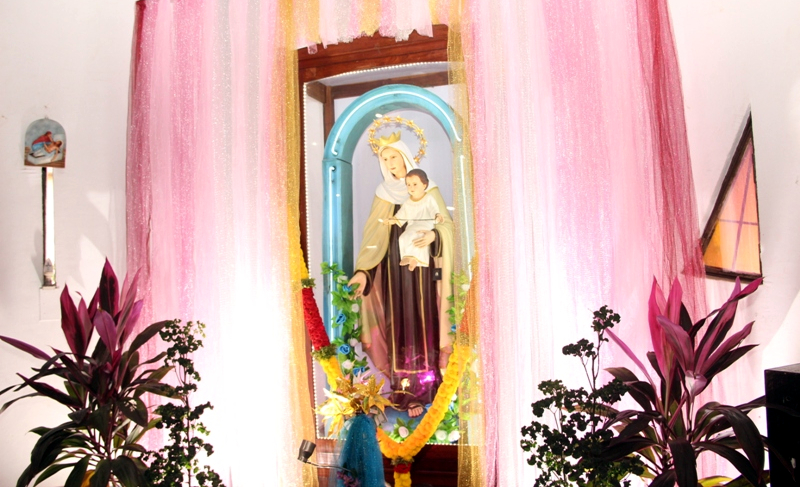
Every year on July 16, the feast of Our Lady of Mount Carmel reflects deeply within the Carmelite Order, serving as a touching reminder of their spiritual heritage and profound connection to Mother Mary.
Our Lady of Mount Carmel is the title given to the Blessed Virgin Mary as the patroness of the Carmelite Order. The first Carmelites were Christian hermits who lived on Mount Carmel in the Holy Land during the late 12th and early to mid-13th centuries. They constructed a chapel amidst their hermitages, dedicating it to the Blessed Virgin. Mount Carmel thus became known as Mary’s Mount, where hermit brothers followed her spiritual example and devoted themselves to her.
Mount Carmel fervour in Goa
In Goa, the feast finds vibrant expression in the Carmelite communities like the Carmelite Monastery (Margao), the Divine Springs Retreat Centre/Our Lady of Fatima Chapel (Xellim-Canacona), the Carmelite Seminary (Mapusa), Emmaus Wellness Centre (Mapusa) and the Cloistered Carmel Monastery (Chicalim).
These centres of Carmelite life become focal points of joyous gatherings, where the faithful gather to honour Our Lady of Mount Carmel and reflect on the significance of the Brown Scapular in their spiritual journey.
In particular, the Carmelite Monastery in Margao draws a significant number of faithful for this feast. Apostolic Carmel and Carmelite Religious of Trivandrum communities in Goa also celebrate this feast.
Churches and chapels dedicated to Our Lady of Mount Carmel, such as those in Arambol, Ponda, Telaulim, and Anvottem-Curtorim, further attest to the deep-rooted devotion within the local community. The Carmel College in Nuvem and schools in Arambol and Curtorim are named in honour of Our Lady of Mount Carmel.
Brown scapular
The feast, originating in the 14th century, commemorates pivotal moments when Carmelites sought Mary's protection, notably during the 1274 Ecumenical Council. Central to Carmelite devotion is the Brown Scapular, symbolising a belonging to the Carmelite family and commitment to Mother Mary's virtues. Monks wear a large scapular daily, reminding them of Christ's teachings and their spiritual goals. Aspiring lay people wear a smaller scapular, signifying their consecration to Mary.
The Brown Scapular of the Carmelite Order typically bears an image of Our Lady of Mount Carmel on one side and the Order's Coat of Arms on the other, symbolising the spiritual protection and maternal care Mary extends to those who wear it devoutly.
For Carmelites, both religious and lay, the scapular holds profound spiritual significance as a sacramental – a sacred sign of devotion and a plea for grace.
Throughout history, saints and blessed members of the Carmelite family, such as St Teresa of Avila, St Thérèse of Lisieux, and St Teresa Benedicta of the Cross, cherished the Brown Scapular as a tangible expression of their devotion to Mary.
Their writings and experiences reflect deep spiritual connections to Our Lady of Mount Carmel, embodying virtues of faith, humility, and prayerfulness that inspire Carmelites and devotees alike.
The enduring popularity of the Brown Scapular is underscored by Papal endorsements and church documents, paralleling the veneration of the rosary.
Popes like Pius XII and Pope St John Paul II have emphasised its significance, with the latter sharing personal sentiments about wearing the scapular close to his heart for many years. Pope St John Paul II's words during the 750th anniversary of the scapular's bestowal resonates deeply: "I have also worn the scapular of Carmel close to my heart for many years!"
The scapular is not merely a symbol but a spiritual "Armour of God," offering protection and guidance to those who wear it with devotion. It serves as a constant reminder of God's love and Mary's intercession, inviting believers to emulate Mary's virtues and draw closer to Jesus Christ. This sacred garment fosters a deeper relationship with God in daily life, reinforcing the conscious choice to follow Jesus through Mary.
Blessed Isidore Bakanja's life exemplifies the profound impact of the Brown Scapular. A humble labourer from Congo, he courageously defended his faith, even facing martyrdom rather than renouncing his beliefs or removing the scapular. His unwavering devotion earned him the title of Blessed by Pope John Paul II – a testament to the scapular's enduring significance in fostering spiritual courage and resilience.
The feast of Our Lady of Mount Carmel and the Brown Scapular are important symbols of faith. They help believers connect with God through Mary's help. Carmelites worldwide celebrate these traditions, finding solace and strength under Mary's care.
(The writer is a member of the Karnataka-Goa Province of the Order of the Discalced Carmelites, based at Avila Jyothi, Carmelite Seminary, Peddem Mapusa).